What Makes This Composition a Valuable Work of Art?
Create powerful creative compositions: 21 pro tips
Strong artistic compositions are vital to the success of a piece of art. The composition of a piece is what captures a viewer's eye and holds their attending in one case they have a closer look.
Artistic composition tin totally change the mood of a slice of fine art, irresolute it from vibrant free energy to solemn contemplation. But how does this happen? Why do some seemingly beautifully rendered pictures fail to hold up whereas others captivate viewers?
Many rules dictate what makes a good composition, for example the Golden Ratio, the Gilded Spiral and the Dominion of Thirds. Yet, it is crucial we don't approach these theories as unbreakable rules but see them as suggestions, or optional templates.
- How to draw: the all-time drawing tutorials
Nosotros'll talk over some of these techniques throughout this article, explain why they are successful and how yous can use that cognition to make a better image.
To begin, all yous actually need to know is this: a good composition is zilch more than a pleasing arrangement of shapes, colours and tones. That'south simple enough really. Chances are, most of yous can brand a good limerick with your eyes closed.
Click on the icon at the top-right of the epitome to overstate it.
01. Tell the story
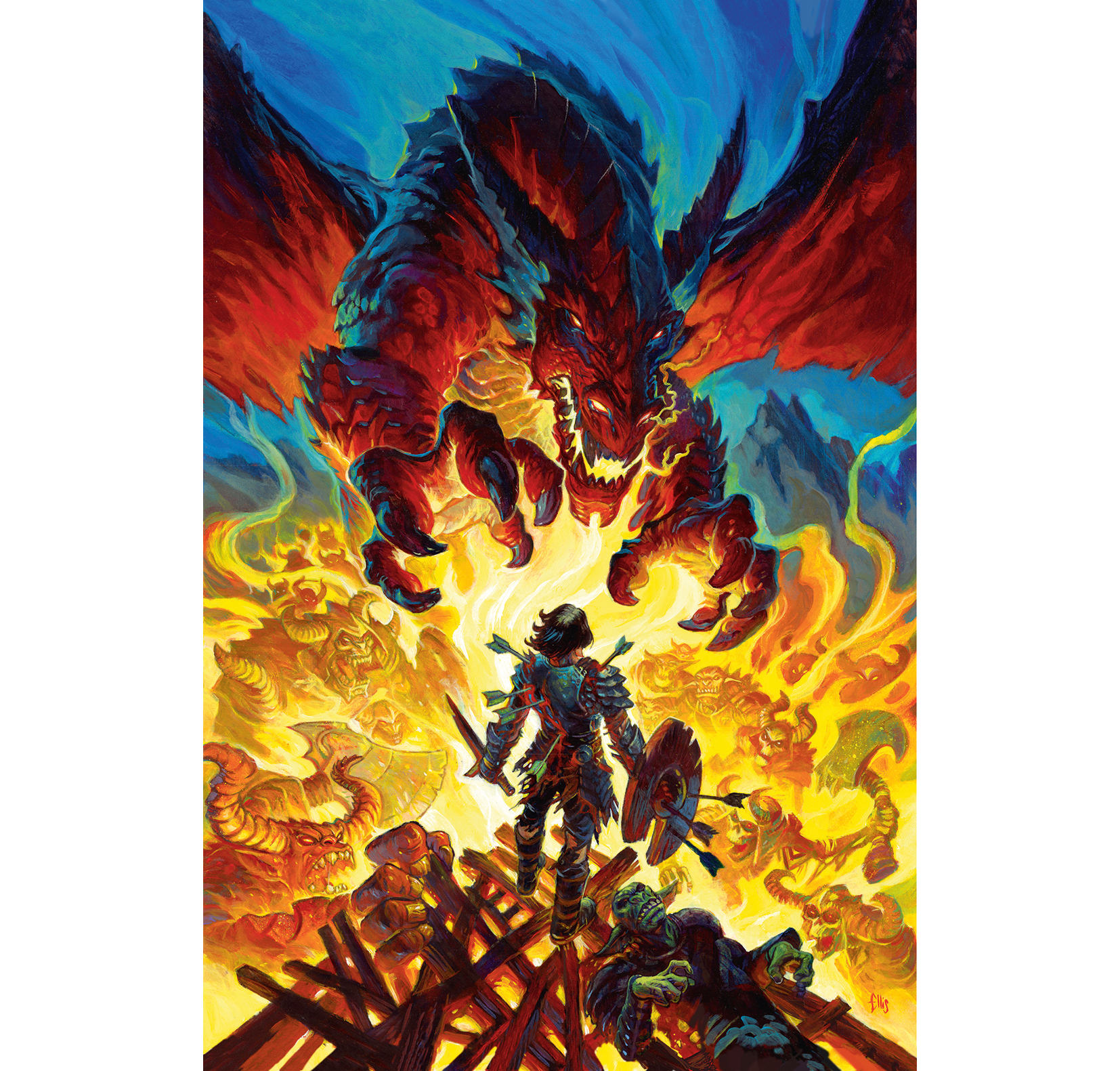
Whether it's a professional brief or notes for a personal piece, the showtime stride is to think about the story. Which elements are crucial to telling the story, which are secondary, and which add tertiary back up? This is how you figure out the hierarchy of elements in your piece. Hither, the confrontation between the warrior and the dragon should be paramount, but the secondary elements, such as the wrecked wooden platform, need to back up the central narrative of the slice.
02. Create relationships

As simple equally this image is, it already has a sense of movement, and depth. How?
Through relationships. Causing a disparity between the shapes has given the viewer a means by which they can compare those shapes. "This one is bigger, that one is lighter." The grayness square appears to be moving and receding just when compared to the blackness foursquare.
The process of comparison these shapes requires that the viewer moves their eyes repeatedly effectually the canvas, and therein lies the truthful goal of a great limerick: controlling that eye movement.
03. Recollect in thumbnails
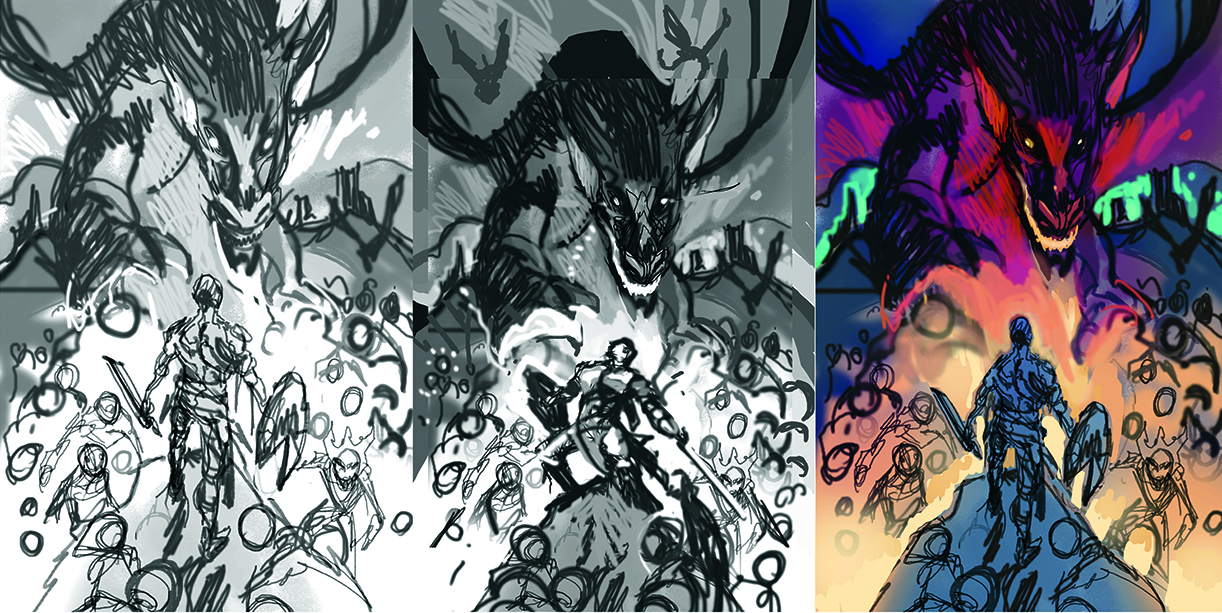
Start with thumbnails that are the same size ratio and orientation as your terminal paradigm. If the thumbnails are at the wrong dimensions, you'll stop upwards with all your balances off-kilter, and have to rework your design. During this early stage it'southward important to solve many of the design bug earlier even thinking about the final image. The delicate balancing of elements tin pb to a potent paradigm, while a slight misplacement can change or alter the touch on of the image you're creating.
04. Know shape matters
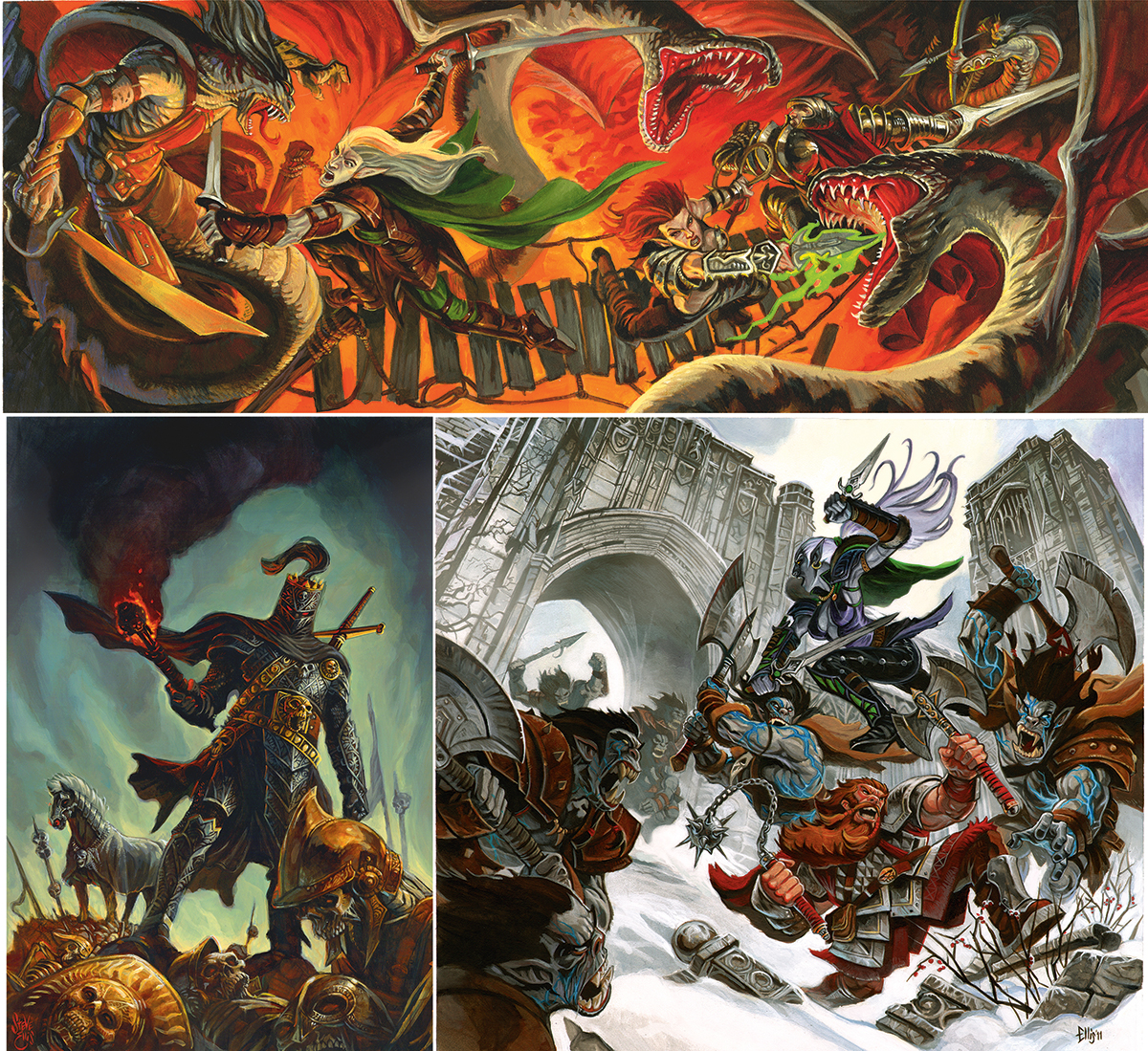
Plan for the outside shape of the image. This is a personal slice, therefore the size was able to be prepare. Commissioned pieces don't allow for this luxury and the artist has to react to the dimensions provided. Everything in your paradigm needs to relate to the border dimensions. That's why the canvas size is crucial. It creates the framing device for the image – the shape that the viewer volition be looking through. Once the outer dimensions are established, the blueprint can exist approached from a few different directions.
05. Develop dynamic symmetry
Dandy compositions use geometry. Hither's an example of how dynamic symmetry helps to take this piece to a deeper compositional level…
a) Line art
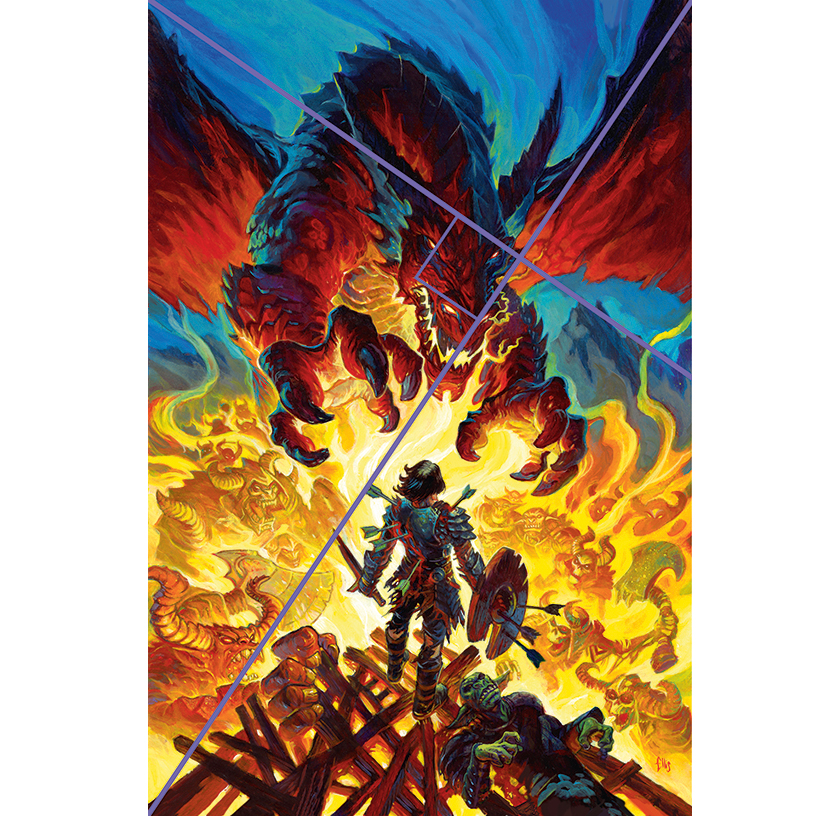
Using the initial sketch, draw a line from the top right corner to the lower left corner. So, from the top left corner describe a line at right angles to the outset line. This is the master point of involvement, and where y'all'll pigment the dragon'southward eye.
b) Identify edges
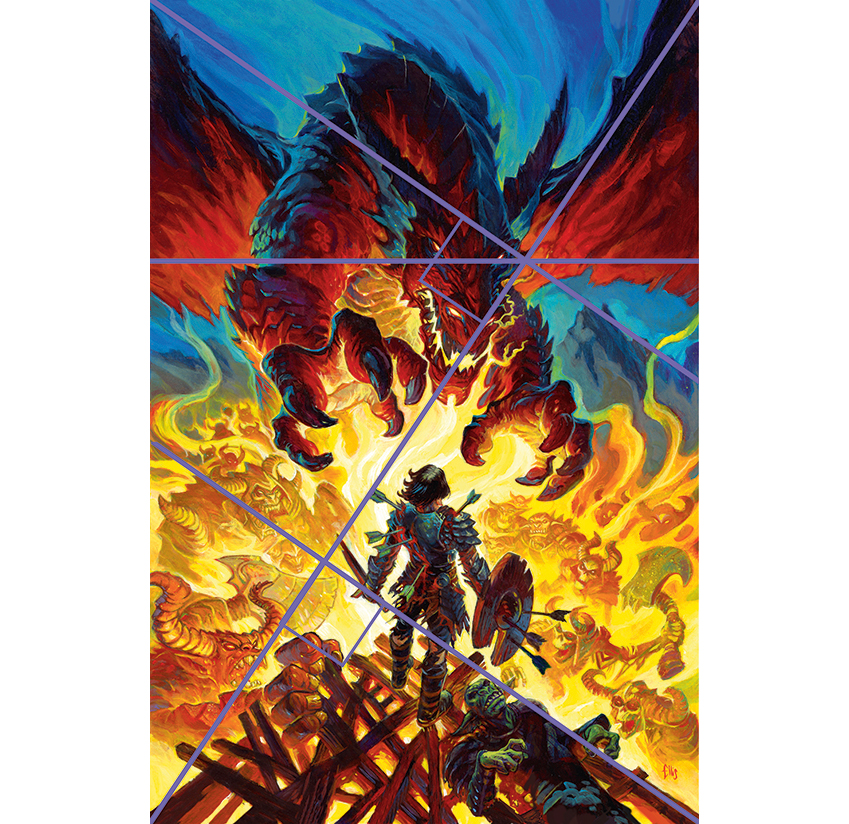
Draw a line direct across at the primary point to plant the dragon'southward eyeline. Then place a line from the lesser right corner at a correct bending to the original line. These help to plant of import elements like the edge of the platform, the orc's side and the dragon's wing.
c) Check placement of elements
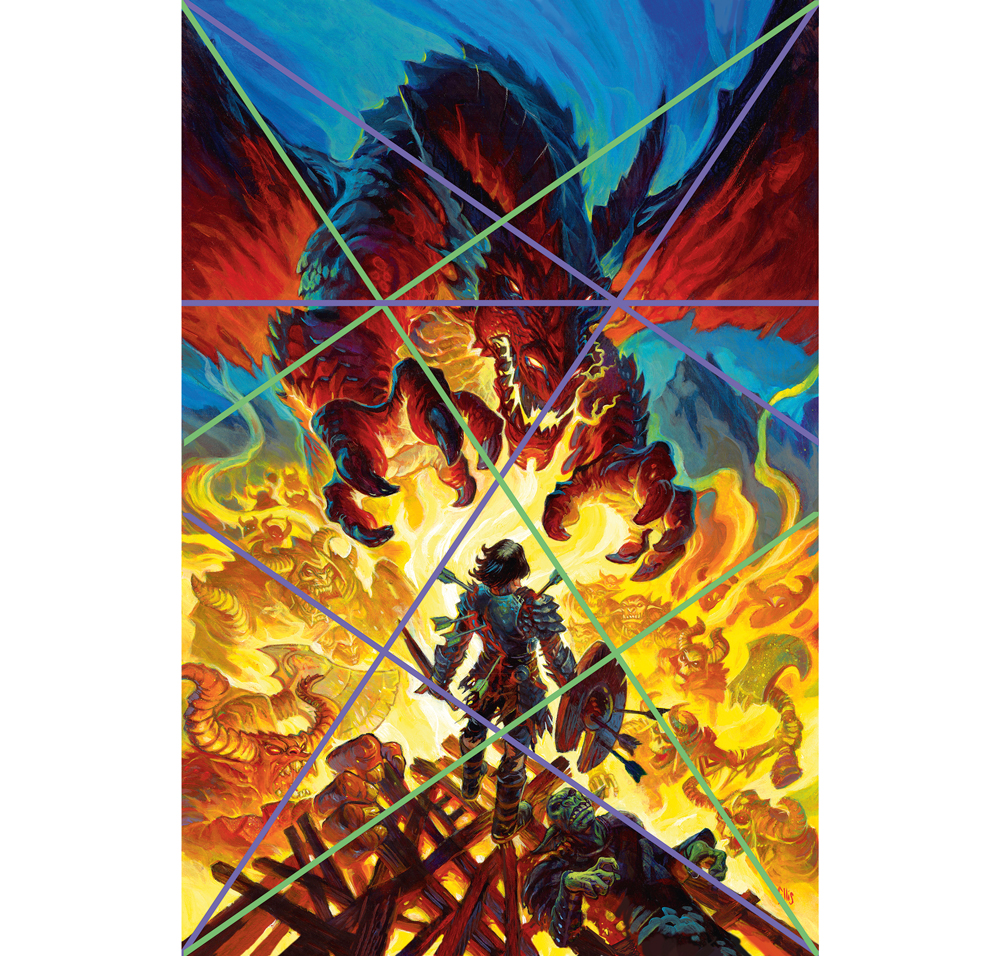
Next, repeat these steps, starting at the top-left corner. Using these guides, locate the border of the platform, the left wing and the warrior's hands. This enables you to meet that the warrior is right in the heart of the diamond shape. The dragon's caput, shifted right, is at present in the upper diamond
06. Apply the Golden Ratio
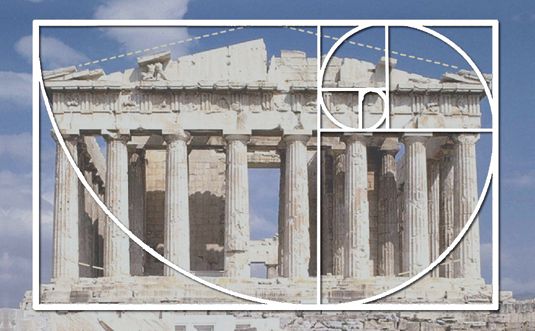
Sometimes, dynamic symmetry doesn't feel right for a piece and this is where The Golden Ratio is nearly useful. This Greek mathematical equation expresses itself every bit a screw. Many of the most famous pieces of art use this ratio to determine on the placement of elements and every bit a natural manner to lead the eye beyond an image. It's so embedded in our natural globe and our humanity that nosotros often use the ratio without realising it.
They believed that all things, both tangible and intangible, take a perfect state of being that define them. They besides felt that 1 should always strive toward achieving this ideal state, be it in mathematics, 1's physique, politics or aesthetics.
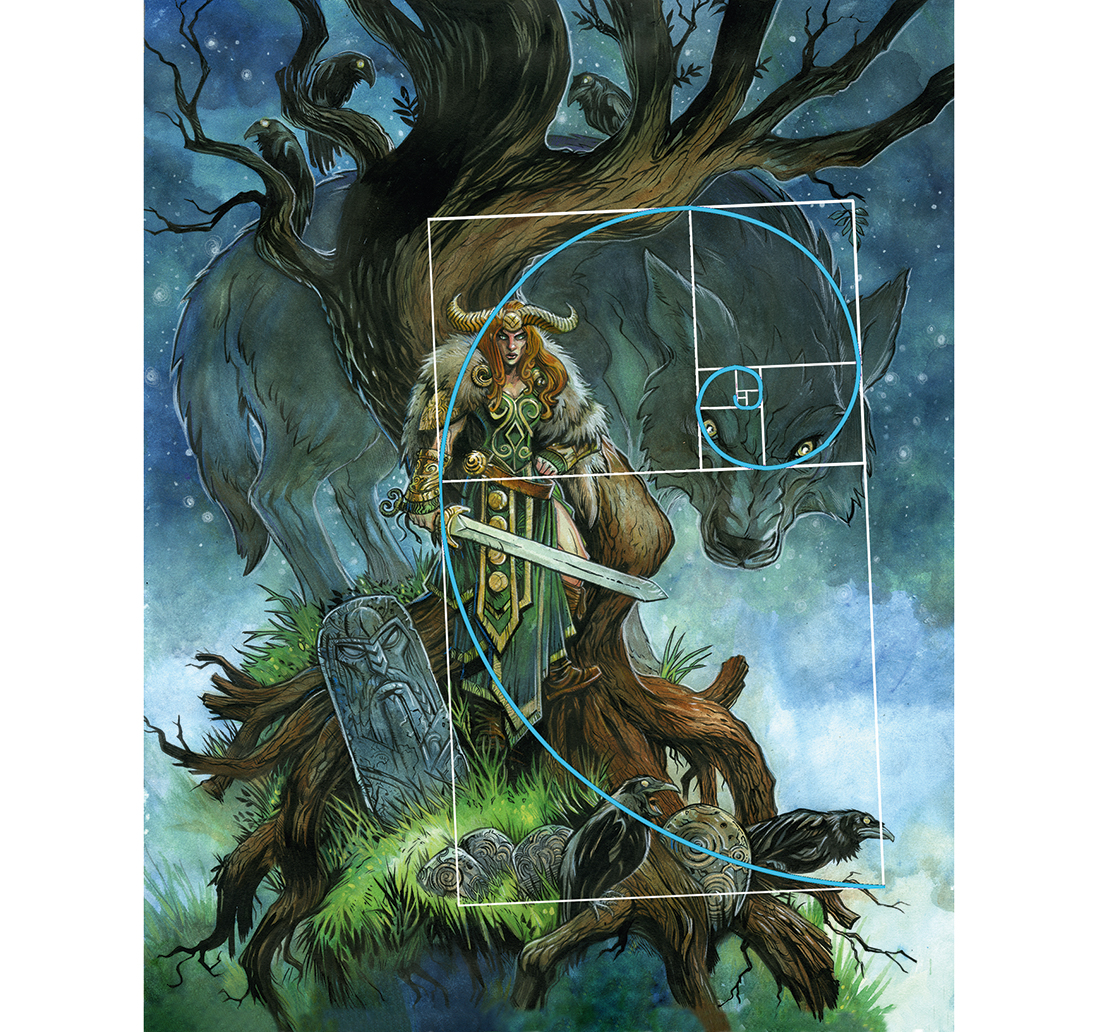
Greek mathematicians, after repeatedly seeing similar proportions in nature and geometry, developed a mathematical formula for what they considered an ideal rectangle: a rectangle whose sides are at a 1:1.62 ratio.
They felt that all objects whose proportions exhibited this were more pleasing, whether a building, a face up or a work of art. To this twenty-four hours, books and even credit cards still suit to this platonic.
In the case of the image above, the screw has been used to create a harmony for the elements of involvement, such every bit the wolf'south eyes, Morrigan, the tree and the ravens.
07. Channel The Rule of Thirds
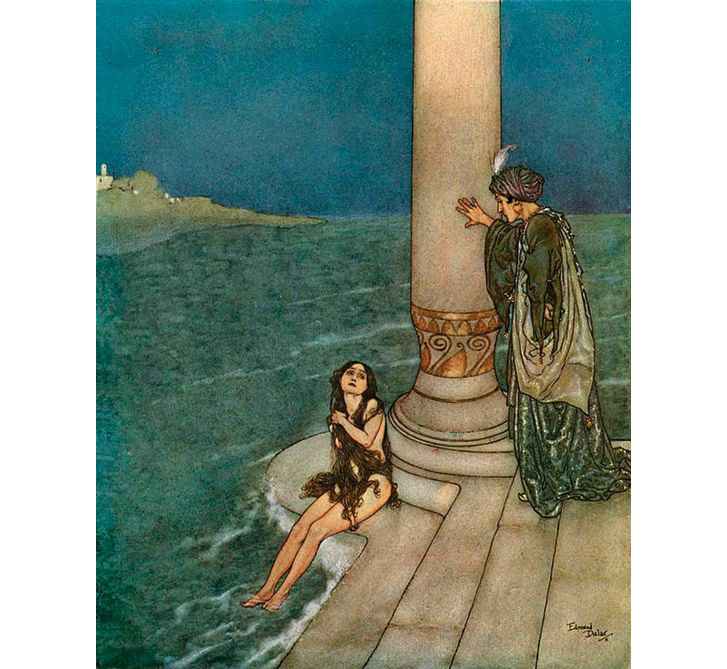
This states that if you lot split whatever limerick into thirds, vertically and horizontally, then place the primal elements of your image either along these lines or at the junctions of them. You lot'll achieve a more pleasing arrangement. But does it work?
Allow's look at Edmund Dulac'due south painting, The Piddling Mermaid: The Prince Asked Who She Was (higher up). Dulac was great at using empty space to his advantage, partly because he tended to abide by the Dominion of Thirds.
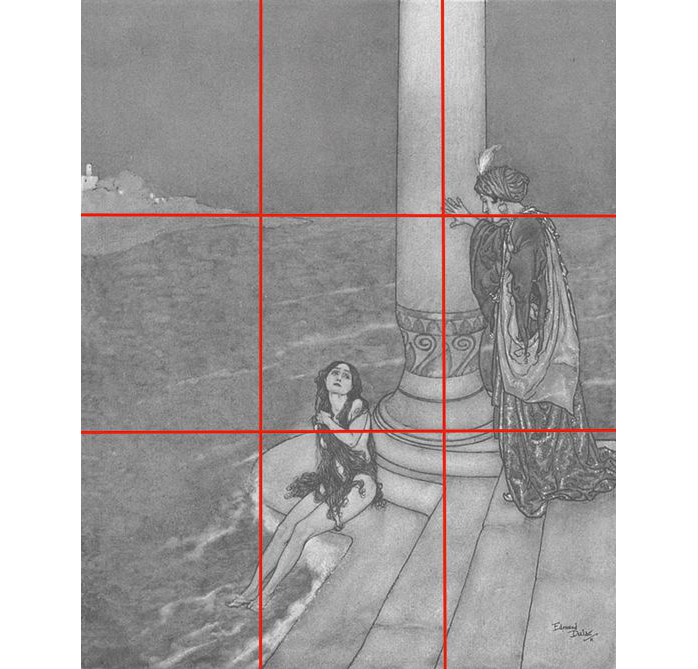
Here Dulac has placed the column and the horizon line perfectly forth a line of thirds. But what if he didn't?

With the column and horizon line in the centre of the image, the outcome is less successful. The cavalcade dominates the image, stealing focus away from the figures.
The viewer's eye is now glued to this stiff shape that bisects the canvas, instead of wandering effectually the prototype like information technology originally did.
08. Learn how the rules piece of work
The Dominion of Thirds works considering information technology demands that the artist makes one element more than dominant than another. This say-so creates an imbalance, and an imbalance of whatsoever sort will always attract the viewer's eye.
Bisecting an epitome perfectly in half creates the to the lowest degree amount of interest, because everything is equally balanced.
Making 1 surface area of your composition more dominant creates tension, and therefore adds involvement. Information technology likewise makes your eyes move around the sail more to compare all of these relationships.
The fact that the composition is divided into precise thirds is actually of minimal significance. You could divide a composition in fourths, fifths or even tenths. So long as there'due south some sort of imbalance, the composition will exhibit tension. As y'all'll shortly see, this concept of imbalance applies to many aspects of composition, including value and colour.
09. Use unsaid lines

These are probably the nearly of import attribute of a composition, because you notice them first. When painting realistically, there's no actual line around a subject.
The illusion of a contour is a result of different values and colours contrasting. But even the impression of a line is strong, and our eyes volition go to it and follow its length until it ends, or until it meets another line, which we'll follow once more. A dandy composition makes stiff use of this natural attraction to lines.
Sweeping activity or movements beyond a slice will draw the eye from ane side of a composition to the other. Using stiff, directly action lines built into elements of the moving picture can movement the eye to the point you want. In non-action pieces or in the calmer areas of activity scenes, use elements such as flowing textile, crimper fume or even directional castor strokes in the heaven – all subtle trails that the eye can follow to the image's focal point. Here, the waves, the tentacles and the shape of the canvass direct the middle.
ten. Reinforce those focal points
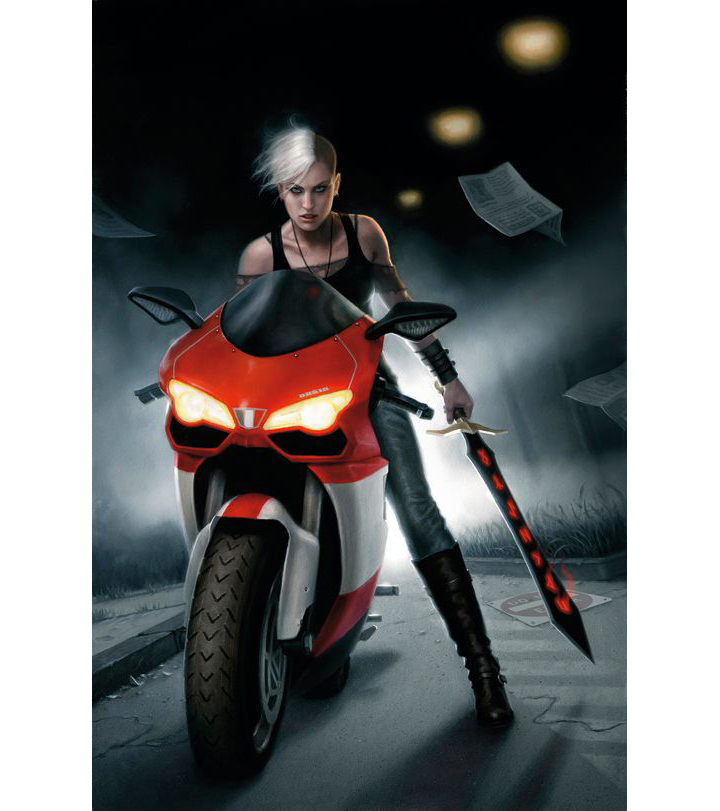
As well as using unsaid lines to draw the eye all around a limerick, you lot can utilize the same method to brand someone await immediately at your chosen focal betoken.
In fact, you can do it repeatedly, from multiple directions. This is particularly useful when your image is a portrait or a pin-upward, and the character's face is the most important element.
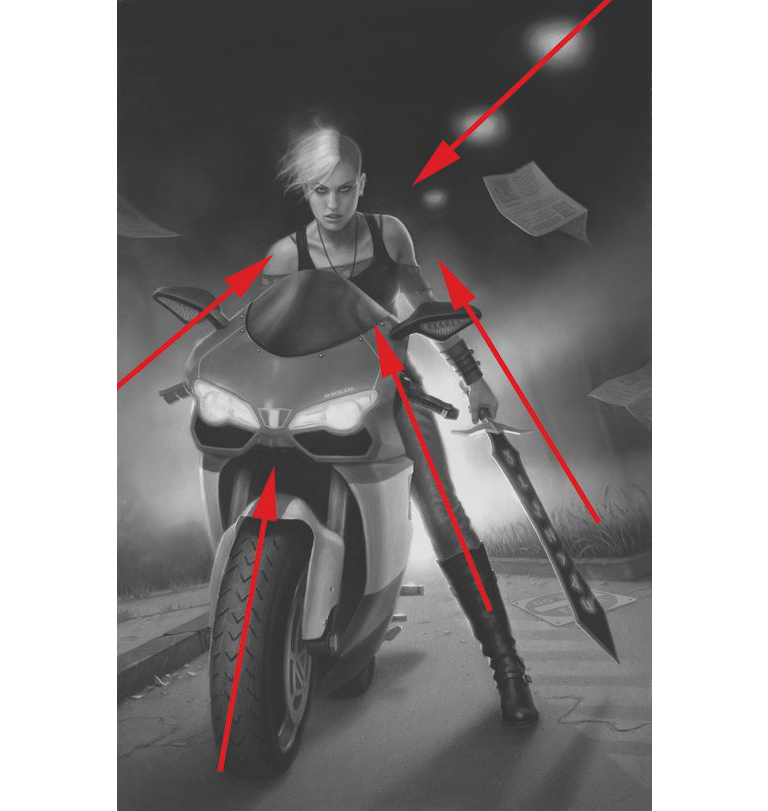
To bring more than attention to a particular character, endeavour to make surrounding objects, such every bit artillery, swords and buildings, indicate to your field of study. You can also use unsaid lines to frame the field of study'due south confront, locking the viewer'south eyes in identify.
eleven. Create drama via a betoken of view
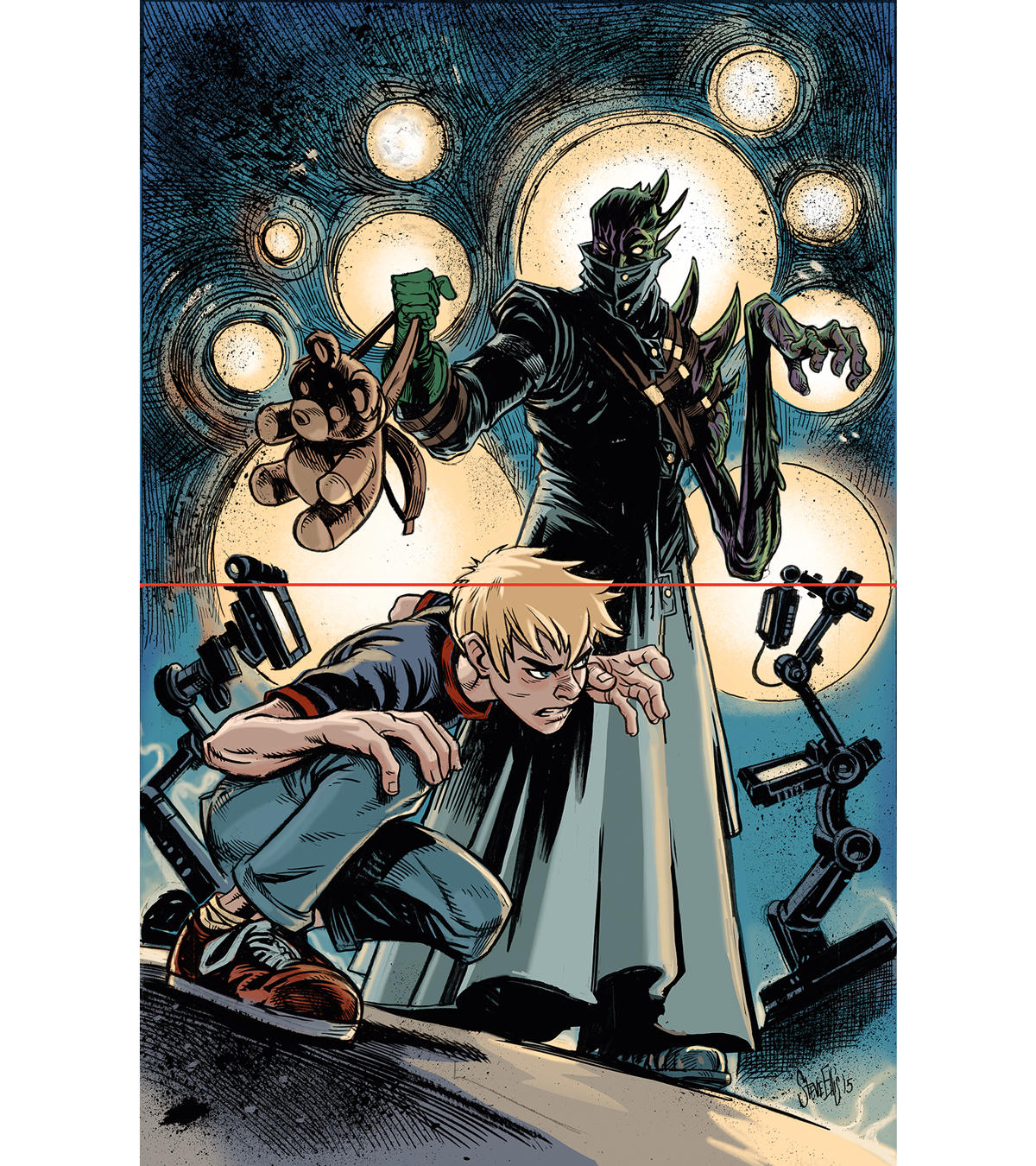
For an emotionally effective piece such as this, the viewer should place themselves in the caput of the warrior. Our hero – and thus the viewer – should feel overwhelmed and outmatched, but still willing to fight. To achieve this, the villain has been placed higher up the midpoint of the picture. The angle has been canted a bit to throw the viewer off-kilter every bit well. That manner, the villain is literally looming over us as well as the boy.
12. See threes everywhere
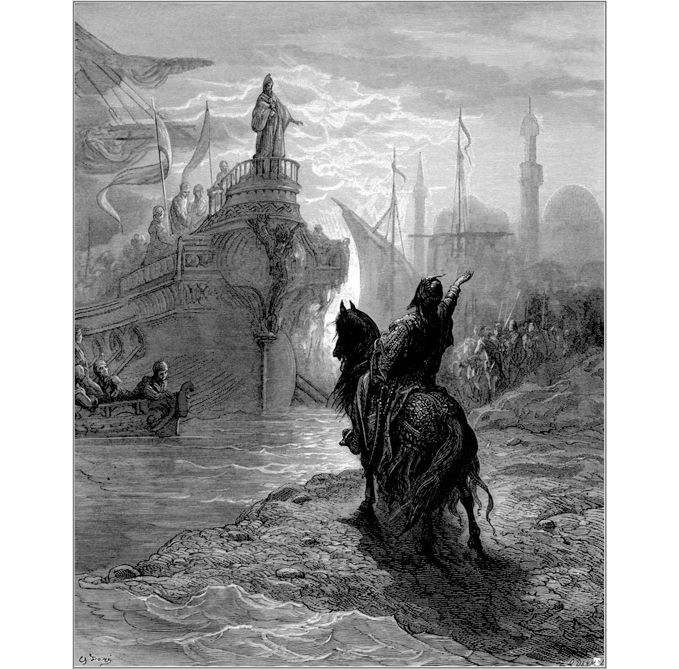
The Rule of Thirds seems to work its way into most aspects of picture making, and value is no exception. When constructing compositions, recall in general arrangements of foreground, heart-footing and groundwork.
To enhance the relationship betwixt these three depths, try to restrict each to a range of value, favouring blackness, white or grey. For instance, y'all tin can allow the background predominately be white tones, the middle-footing predominantly greys and the foreground predominantly black tones.
Of course, any organization of these iii values volition work. By restricting your values in these areas you reinforce your image'due south sense of depth and make the silhouettes very like shooting fish in a barrel to read – and that legibility is of import.
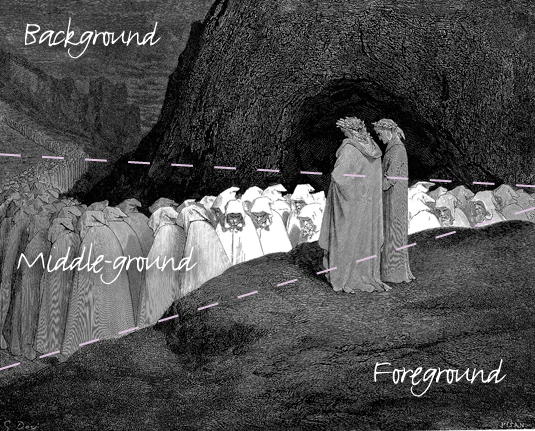
Muddy values injure the viewer's ability to discern shapes, especially at a small scale. That'south why y'all'll run into this technique used and so oft in trading bill of fare art. When your image is just a few inches tall, high-dissimilarity compositions work specially well.
Triptych value schemes like this are readily apparent in the works of the Onetime Masters, particularly in the engravings of Gustave Doré.
His paintings all testify dissimilar arrangements of black, white and grayness to emphasise the deviation between foreground, centre-ground and groundwork.
13. Harness the power of triangles
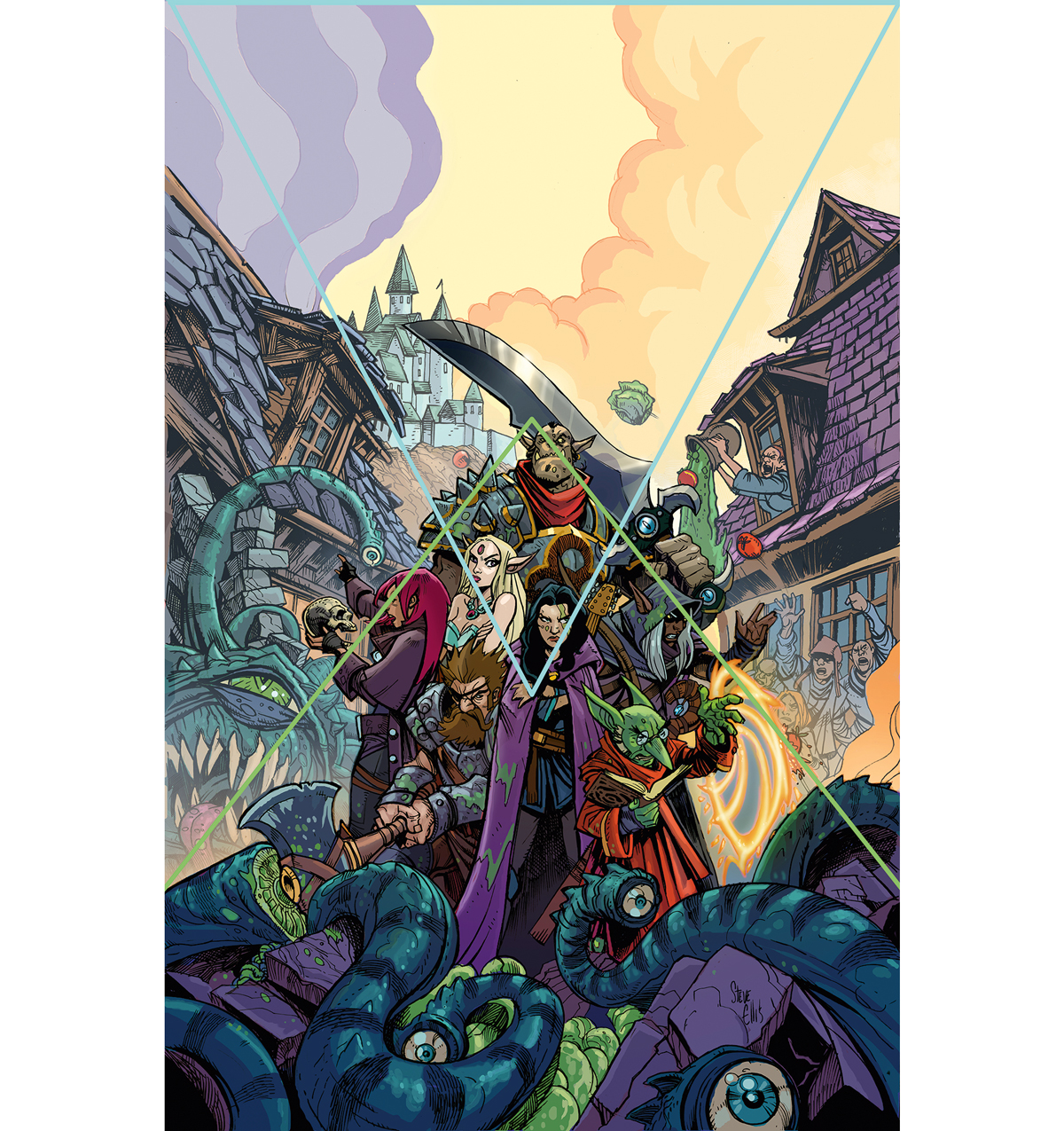
Compositions are often based around strong, simple shapes. Here, the heroes in this piece need to take an private moment to themselves, but as well to fit together as a team. Considering a triangle is a potent shape the team has been equanimous so that its various elements led the centre to the orc paladin'due south head (the green triangle). And because the groundwork is as well bundled as a downwards-pointing triangle (the blue triangle), information technology creates a diamond shape where the heads of the main figures are approximately placed. All of this is meant to pull the reader towards the expressions on the characters' faces.
fourteen. Be clever with colour
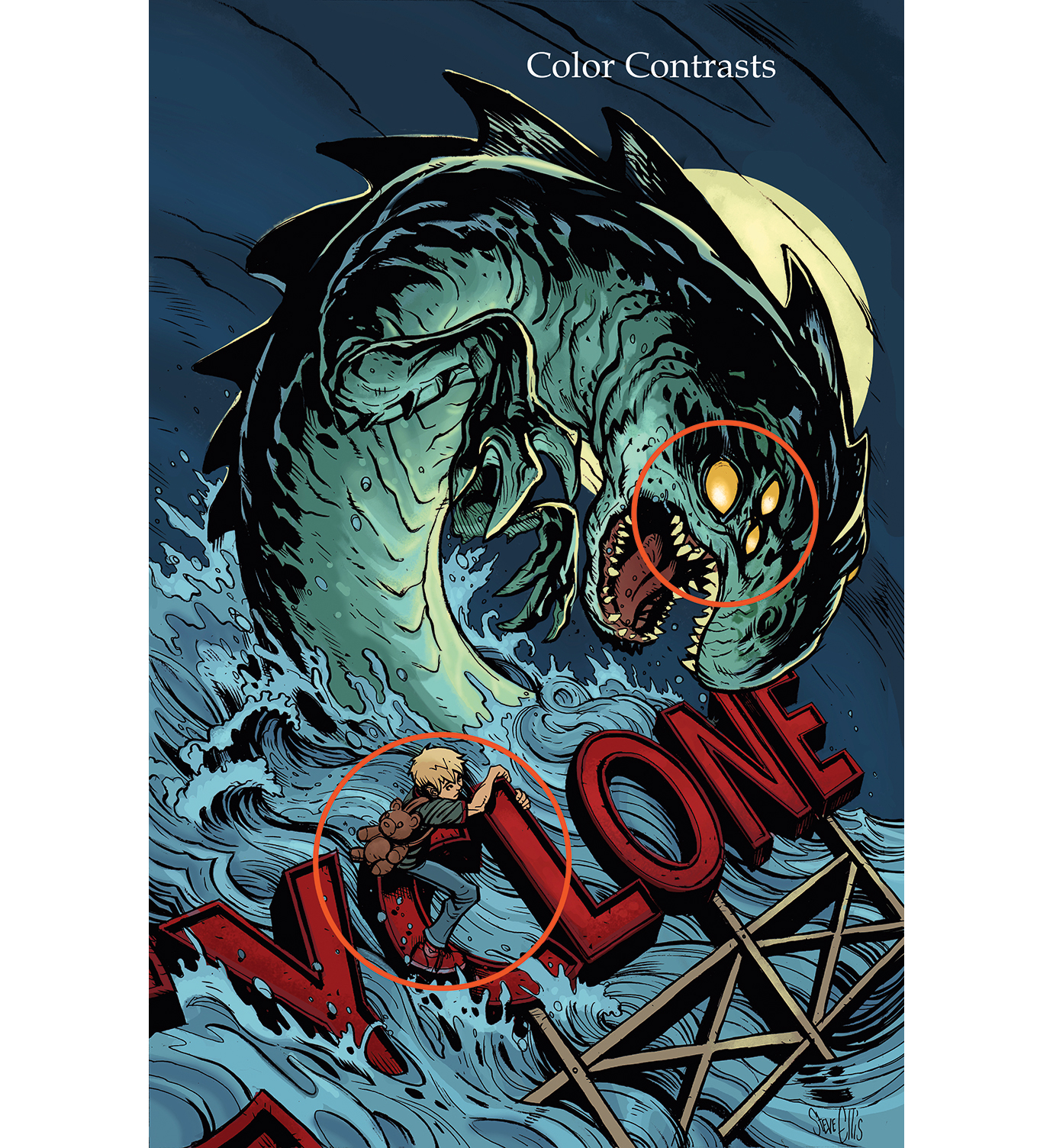
Colour is an amazing tool for composition. In a piece where I desire something to hitting hard I'll apply a lot of contrasting value of colour also as complementary colour. A bright warm colour in the middle of a field of absurd tin can really pop out of a scene and draw the viewer's eye. Here, the word 'Cyclone' is a dark cerise then that contrasts confronting the blue of the water, while the eyes of the serpent are bright xanthous against the dark turquoise of the heaven. The boy has been highlighted with yellow and a lighter peel tone, to bring him forward against the sign and the water.
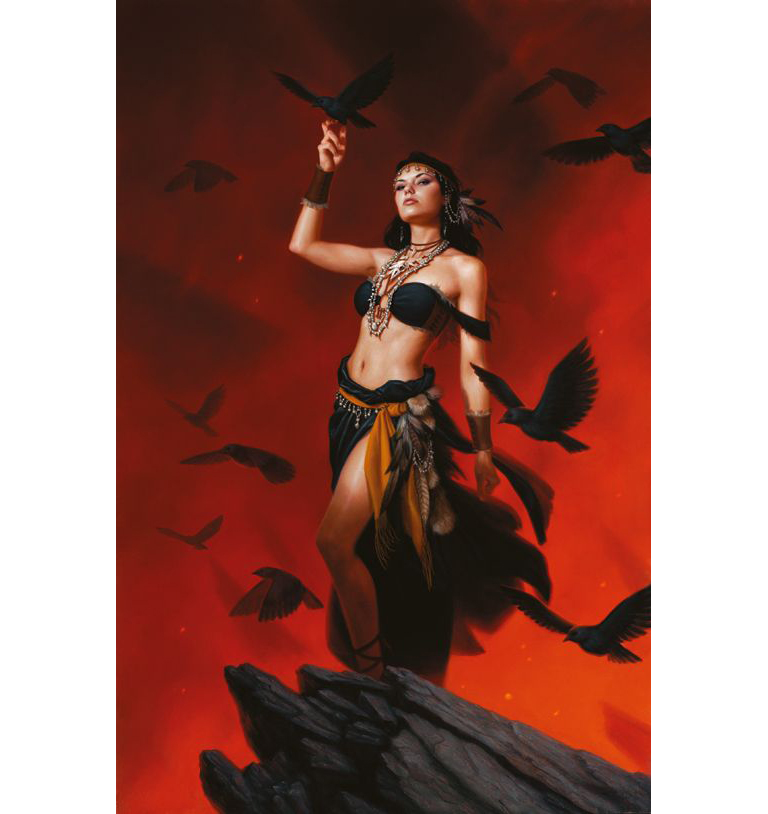
Black and white are inherently powerful tones. If you use them sparingly, and right next to each other, you tin draw the viewer's attention to a particular spot with ease.
When painting, endeavor reserving the purest whites and blacks for your focal bespeak. For instance, if your primary character has very pale peel, try placing something extremely dark on them, such every bit black pilus or black clothes.
This is one of the easiest and most successful means of making your discipline pop. In the above painting, Claret Divided, this has the effect of sitting the heroine apart from the background.
15. Consider your angle
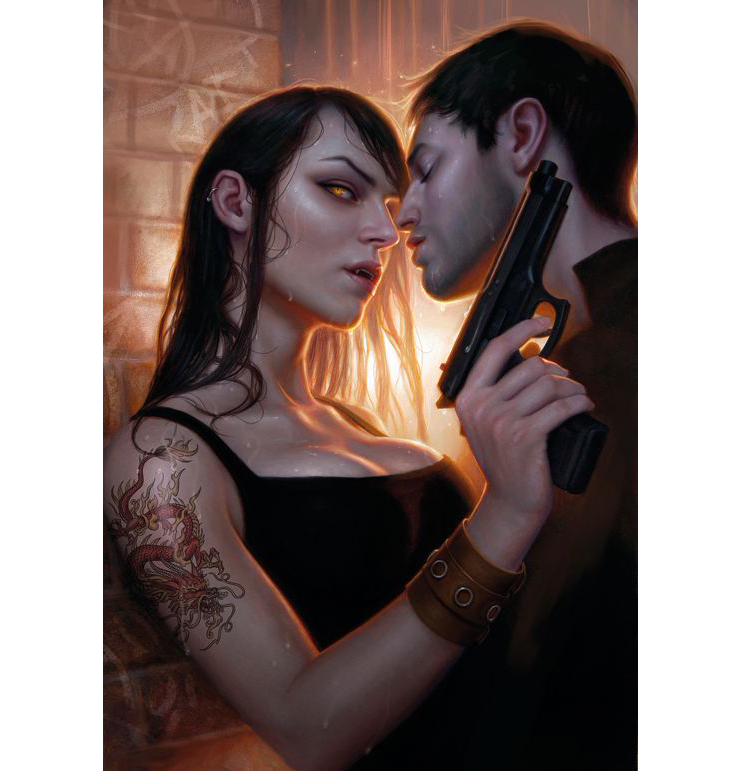
Imbalance can create a more exciting period to your composition, but it can also add drama. The side by side time your painting isn't exciting enough, try tipping the camera bending.
Even the slightest tip to the horizon line tin can turn a mundane scene into a absurd action shot. Experiment with the psychological impressions that unlike camera angles create.
Directly, this painting lacks existent excitement. The bricks, pelting and hair all create unproblematic vertical lines, and don't practice much to enhance the drama of the piece. Tipping the image gives information technology a whole new experience.
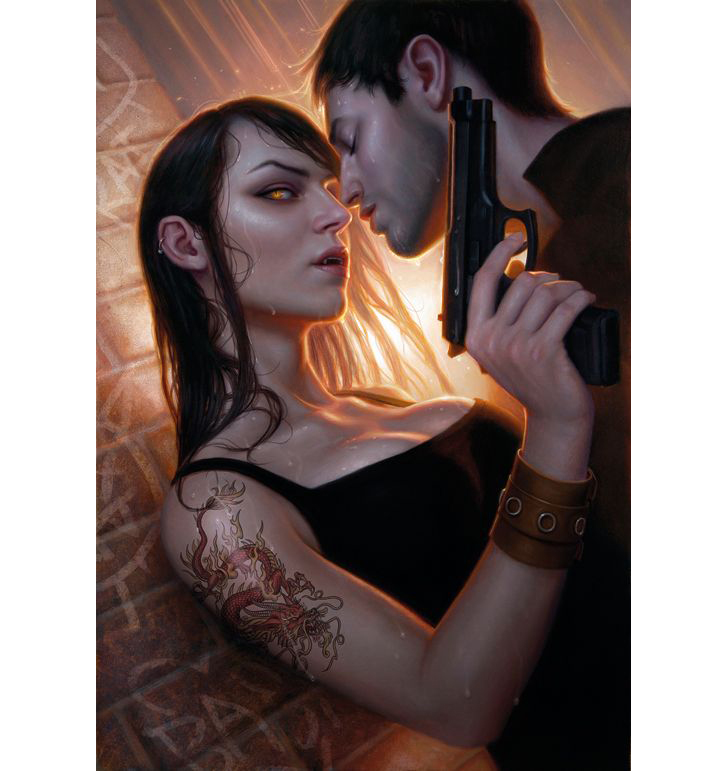
Suddenly information technology appears like the woman is being thrust against the wall. There'southward also more of a sense of weight to their poses
16. Assess the silhouette
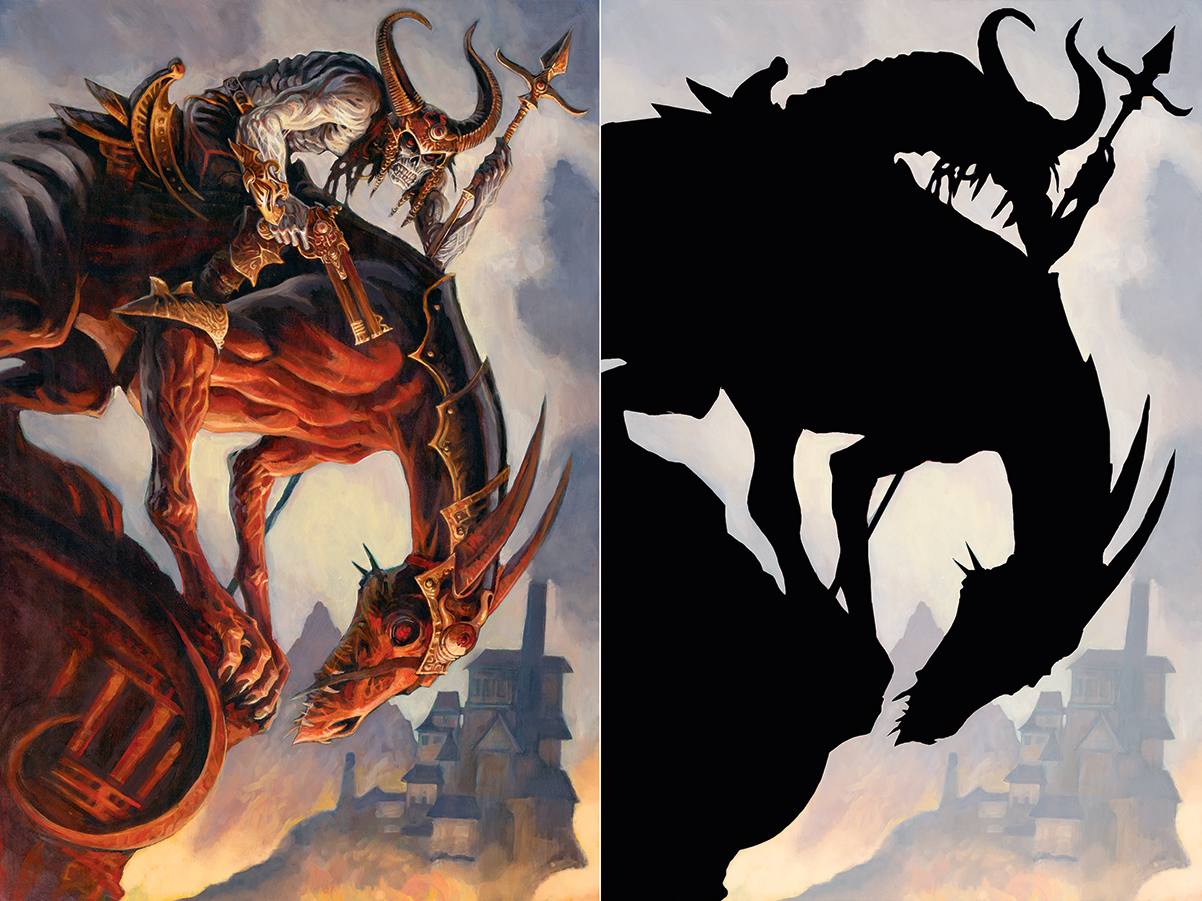
When planning a painting, think about how the image will look as a silhouette. Compositionally, the silhouette is the outer edge of the main forms of the foreground objects or figures. If it works in blackness and white as a limerick then there's a good take a chance that the composition should piece of work fine in colour, if yous don't mess around with the colour values besides much. Also, make sure that the silhouette is interesting and groundwork elements don't compete with it.
17. Vary symmetry or asymmetry
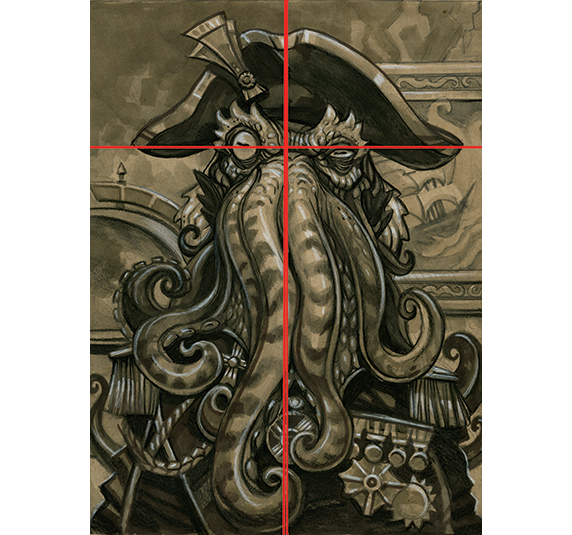
Symmetry is corking at telegraphing order and calm, but it can be pretty unexciting. Sometimes, equally with this portrait, think about bilateral symmetry, merely vary the elements a chip to go along the slice feeling active: the expression in the eyes, and the positioning, shape and size of the unlike tentacles, for example. Also rest the background elements without repeating them, and so that they retain a sense of energy.
18. Play it big and bold
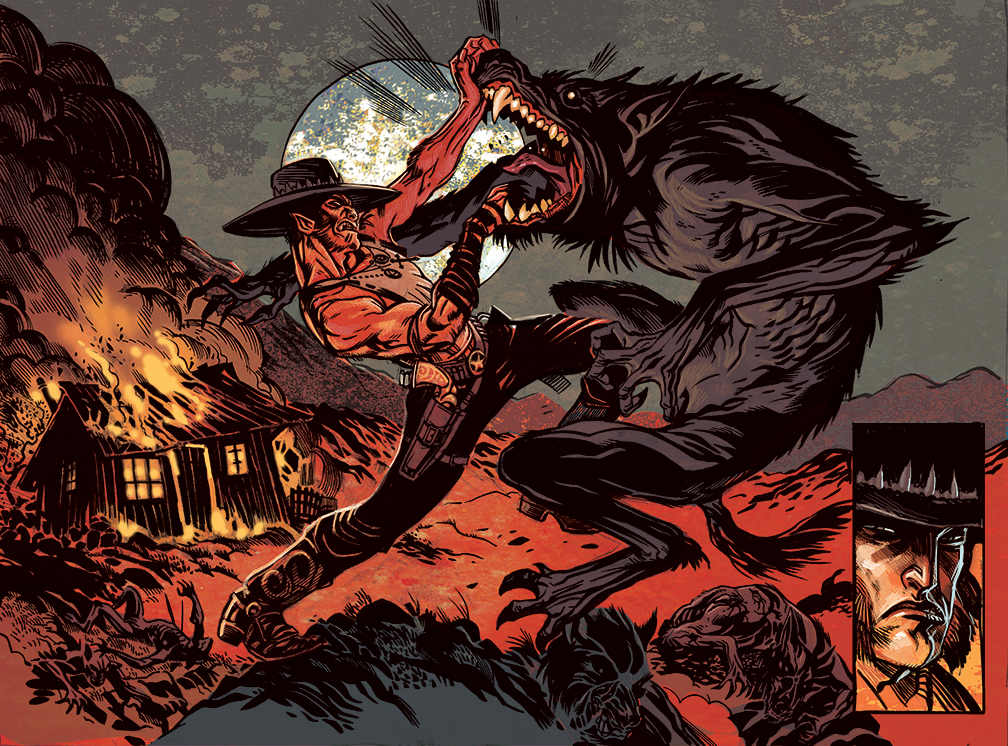
Sometimes information technology pays to exist blatant with your pattern elements. Just look at any Norman Rockwell Saturday Evening Post encompass. I'll often utilize a behemothic circle on one of my points of involvement in a piece, creating a halo around the primary grapheme or activity. This draws the viewer's attention to anything that breaks out of that circumvolve. Taking this approach too works with other uncomplicated shapes, such equally a diamond or a triangle.
19. Call up ahead to the final product
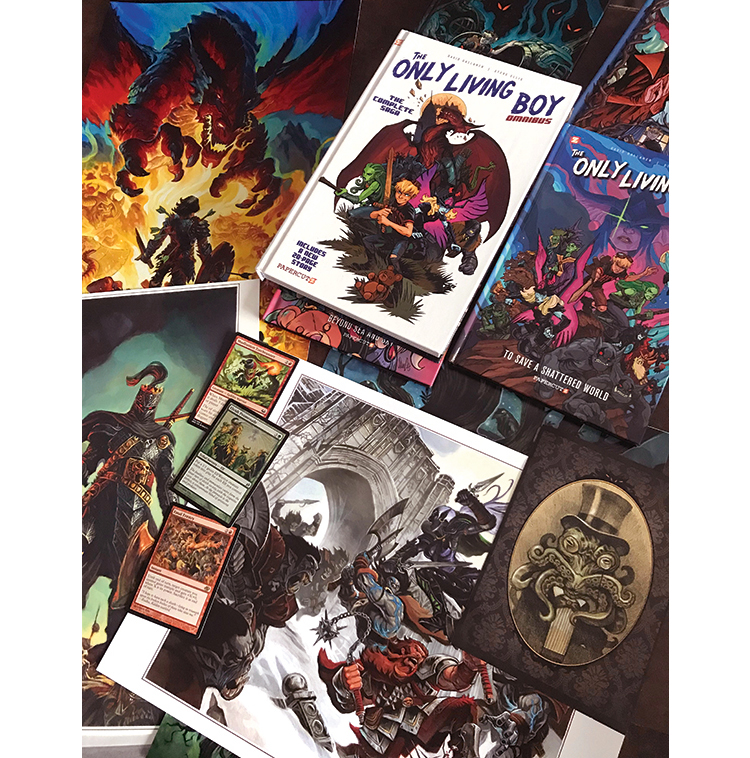
It'due south of import to remember most the terminal home of the art. Is it a game card or book embrace, or volition it hang on a wall? Gallery art has different compositional needs than a card epitome or a 6x9-inch comic book comprehend. While a strong composition will piece of work on many levels, the intensity of detail needed for a larger reproduction may not be necessary for a tiny carte du jour. Simple shape compositions tin be strongest for pocket-sized pieces, only might seem as well simple when enlarged.
twenty. Stay loose
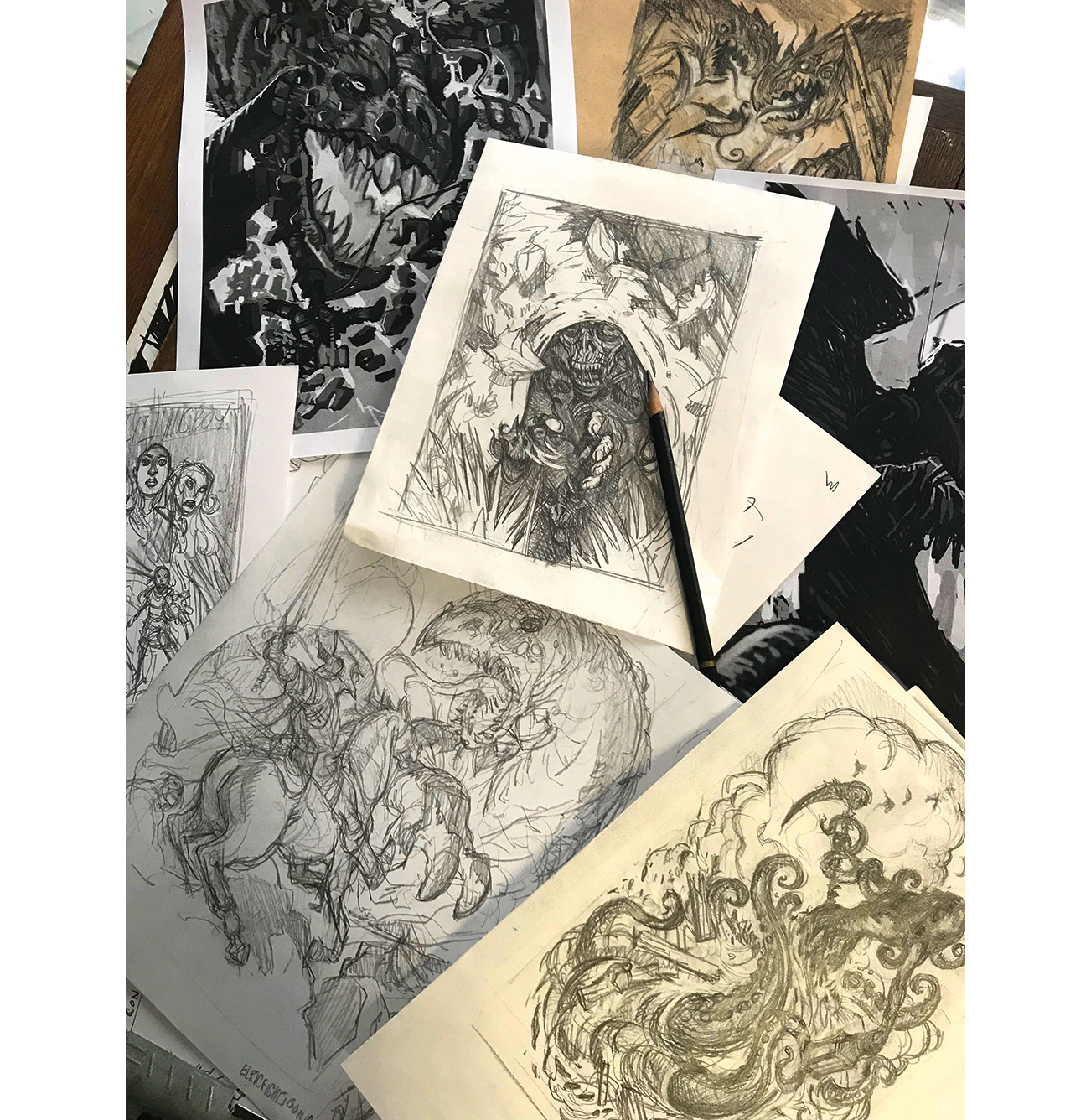
While such advice can assist to create strong images, if they ever go restrictive, throw out the rules and practice some unstructured sketching. Use bigger, looser, bolder strokes and shapes and then go back to these tips. In the finish you lot never want to lose the spontaneity in the image, otherwise it loses its fun. If making the art isn't fun for the artist, information technology won't be fun for the viewer.
21. Put it all together
A adept composition is ane where the artist controls the movement of the viewer'due south eye to a beneficial consequence.
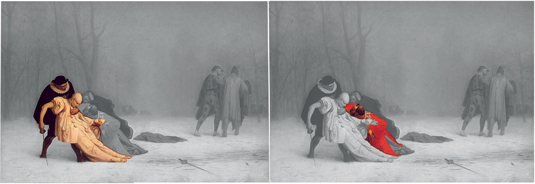
We tin practise this by a number of ways, such equally reinforcing the focal point with the Rule of Thirds, implied lines, contrast of value and selective colour saturation.
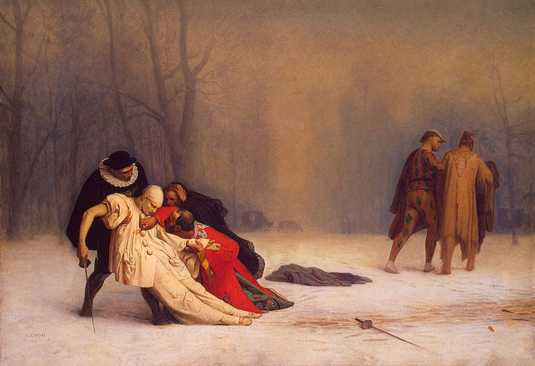
Putting all of these tools into activeness in a single piece, Jean-Léon Gérôme's Duel Later a Masquerade Ball is the perfect example of using all compositional devices to your advantage.
This content originally appeared in ImagineFX ; subscribe here .
Read more:
- Pencil drawing techniques: Pro tips to sharpen your skills
- How to draw muscles
- The best Huion drawing tablet right at present
Related manufactures
Source: https://www.creativebloq.com/digital-art/tips-composition-31514496
Post a Comment for "What Makes This Composition a Valuable Work of Art?"